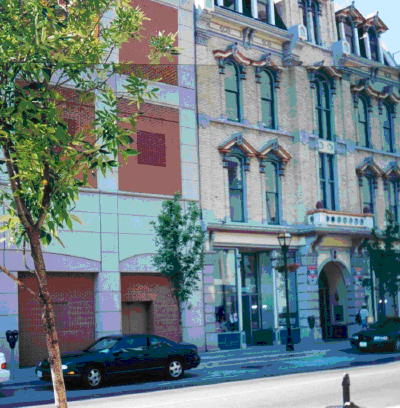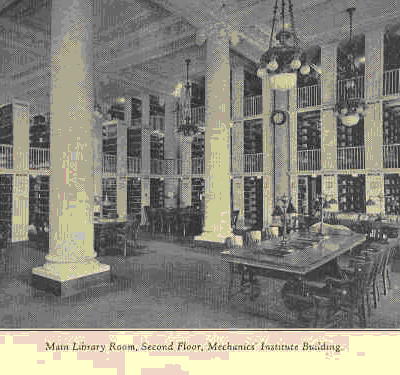Related Categories: History of Reading, Literacy Studies
Original Object for Study description
Summary:
The Mechanics’ Institute sprang up in 19th century England for the ostensible purpose of imparting upon the working class mechanic knowledge of the sciences, literature, and arts. In actuality, a myriad of purposes shrouded the creation of these institutes, which were ultimately appropriated by the middle class when it became apparent that the working class was not as receptive as had been anticipated. Some scholars conjecture that they were really formed as a means of control and indoctrination of the working class, allowing only as little real knowledge as needed for them to improve as workers, but little else. As the middle class began to move in, the working class retreated to the Institute’s libraries and reading rooms, where they were free to discuss topics that interested them. One of the unintended consequences of the failed Mechanics’ Institutes was the aiding in the creation of a democratic infrastructure for working class access to printed materials, and despite the Institute’s discouragement, a predilection for popular fiction. In short, despite being borne from a desire to regulate, they were an important precursor to the establishment of public libraries and a liberated mass reading public.
Description:
Founded by two Professors in Glasgow in the late 19th century, the Mechanics’ Institute began as a series of free lectures by Professors John Anderson and George Birbeck. When John Andrews died, he bequeathed his estate to the founding of an institution of higher learning, which would be led by Birbeck until it was turned into the Glasgow Royal Technical College. Birbeck’s interactions with the eager working class at Anderson’s institute led him to establish a free class aimed at the scientific principles of mechanics, which was a rousing success. This eventually gave him the idea to create an institute, and a Glasgow Institute was created in July 1823, with a London chapter in November 1823. There is some dispute as to the true origins of the Mechanics’ Institutes, with some scholars crediting its establishment to John Broster, a bookseller, Thomas Dick, LL.D., a schoolmaster, or Leonard Horner, a former Warden of University College, London. Regardless of its murky origins, the Glasgow and London incarnations were the most culturally significant.
According to The Westminister Review, the Institute was
a voluntary association of a portion of the humbler classes of a town or locality, assisted by a few of the leading and wealthy inhabitants, to raise, by means of a small periodical contributions, a fund to be expended in the instruction of the members in science, literature, and the arts, to the exclusion of controversial divinity, party politics, and subjects of local dispute, by means of a library of circulation, lectures, evening or day classes, and a reading room (qtd. in Royle 308).
Generally, the Institute was a place for entertaining evening lectures on various scientific, literary, or artistic subjects, held instructional classes, and housed a library and reading room. Depending on the chapter, there were at any given moment three main purposes of the Institute. Educators like Birbeck and Andrews desired to give the working class access to an education for education’s sake. Others thought that more knowledgeable workers would result in increased industrial and economic efficiency. And lastly, some believed that these institutes would serve well as centers for moral and social reform. At its height in popularity, the Mechanics’ Institute had 700 chapters across the United Kingdom, the United States and Canada, indicating that its social relevance and impact was no little thing.
 >
>
The London Mechanics’ Institute (1994)
Despite its initial popularity, the Mechanics’ Institute largely failed to capture the hearts and minds of the working class, and soon found that its facilities, lectures, and advanced classes appealed more to the bourgeoisie than the proletariat. Generally, three reasons are given for the Institute’s decline. One, the lower classes were not educated enough to take advantage of the courses or lectures. When most of the working class had left school by age 12, they had more need of remedial educations than lectures on abstract theories. Two, the educations and purpose of the Institute did not particularly interest the working class in the first place. After a long day of work, most were too weary to extend their miseries. Third, the middle class simply took the Institutes over, coloring their purpose and character to the point that the working class had nothing to do with them. After their decline, many were converted into libraries, schools, intellectual recreation centers (i.e., chess clubs), and even cinema houses.

Research Context:
The Mechanics’ Institute is of particular interest to the field of the History of the Book, Print Culture, and Media Studies. As the first real private initiative towards the increased literacy and education of the newly formed working class of the Industrial Revolution, it offers a glimpse into the formation of a mass reading public from an interaction (or clash) of the upper, middle, and lower classes. At the very least, it gives a sobering view of the importance of ideological motives at the creation of the printed word and the common reader of the word.
Technical Analysis:
With 700 institutions spread throughout the United Kingdom and North America, there is surprisingly little study on the Mechanics’ Institute’s sociological impact. Richard Altick and Frederick Engels writes of the Mechanics’ Institute as a tool of middle-class oppression of the lower class, while others like Ian Inkster paint it as a marker of class divisions in the rapidly changing social order of the post-industrial era. Edward Royle argues that they actually partly succeeded in their original mission of enlightening the working class. Of particular interest may be its effect on kinds of reading material it exposed to its working class members and how they may have influenced their ideologies.
Evaluation of Opportunities/Limitations for the Transliteracies Topic:
Regardless of the political and ideological purposes of the Mechanics’ Institute, it aided in a widespread movement towards universal literacy and public texts for the common public. In terms of the Transliteracies Project, the Mechanics’ Institute’s contribution to the discussion surrounding the practice of online reading may be in shedding light on lower class avenues to online access. Will institutions such as corporations, the state, or the church, in an effort to exert control, begin an initiative to provide public access to online works and instructional classes on technology? If so, what are their motives? More importantly, will they have the desired effect? One of the Mechanics’ Institute’s original purpose was the empowerment of the worker in understanding the science behind his assigned machine, which they in large failed to accomplish, but did result in the empowerment of a different kind. The question is, if today’s laborer of a transnational media-based industry is the third-world knowledge worker, what would result from an entire army of lower class global citizens empowered with access to information? Are the Nigerian spammers the Luddites of today? Reading empowered the English common reader of the 19th century, will online reading do the same to in the 21st century?
Resources for Further Study:
- Altick, Richard. The English Common Reader. Cleveland: Ohio State University
Press, 1998.
- Barker, Donald. “Funding communal culture: opportunism and standardisation of funding for mechanics’ institutes in colonial Victoria.” The Australian Library Journal(2002). 28 Jan 2006.
- Firth, Ann. “Culture and Wealth Creation: Mechanics’ Institutes and the Emergence of Political Economy in Early Nineteenth-Century Britain.” History of Intellectual Culture 5.1 (2005). 27 Jan 2006.
- Inkster, Ian. “The Social Context of an Educational Movement: A Revisionist Approach to the English Mechanics’ Institutes, 1820-1850.” Oxford Review of Education 2.3 (1976): 277-299.
- Kelly, Thomas. “The Origin of Mechanics’ Institutes.” British Journal of Educational Studies 1.1 (1952): 17-27.
- Royle, Edward. “Mechanics’ Institutes and the Working Classes, 1840-1860.” The Historical Journal 14.2 (1971): 305-321.

May 15th, 2009 at 2:04 pm
For people interested in Mechanics Institutes they might like to know about the Conference being held in Bath in late September this year (2009) entitled “Self Help”
(commemorating 150th anniversity of the publication of Samuel Smiles’ seminal work of the same name). It is aimed at all those interested in Mechanics Institutes, Subscription Libraries, Lit & Phil’s, Athenaeums etc. Details can be found at:
http://www.brlsi.org/mechanics09/
and the draft programme to date:
http://www.brlsi.org/mechanics09/programme.cfm